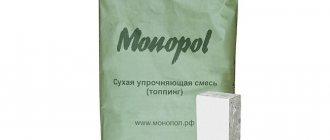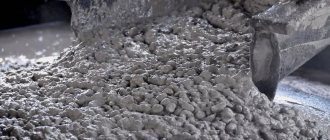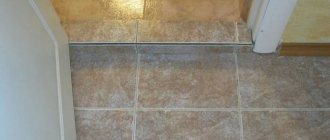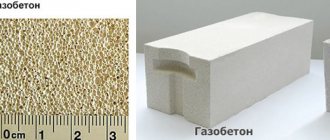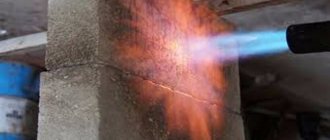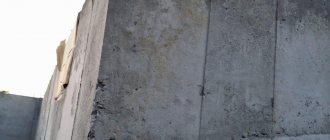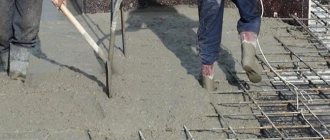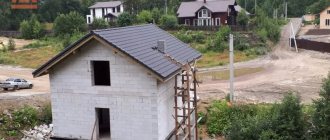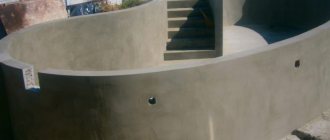Beton-House.com
Website about concrete: construction, characteristics, design. We combine the experience of professionals and private craftsmen in one place
Concrete mosaic covering
Concrete mosaic floors are a monolithic concrete coating consisting of cement and aggregates. The fillers are: marble chips and decorative pigments.
This flooring is characterized by high performance characteristics and durability. We will talk about the nuances of its structure in this article.
- Terrazzo mosaic coverings
- Base structure
MANUFACTURERS
- HAGAst (Noginsk)
- HeatAvangard
- Perel (Shchelkovo)
- Hagastapel (Electrocoal)
- Quick Mix
- Terta
- Osnovit (Kolomna)
- Linolit
- Plifort
Each of these manufacturers, thanks to special formulations and their own technologies, have developed and produce construction, finishing, waterproofing, fireproofing materials with the best technical characteristics for a specific area of application in construction.
Concrete mosaic slab
The concrete mosaic slab made of natural stone is made of marble chips and heavy concrete, reinforced over the entire area with 4 mm reinforcing mesh, using dry pressing and careful vibration, followed by steaming to increase strength.
Concrete mosaic slabs are many times superior to various analogues in terms of abrasion resistance, compressive strength, dustlessness and frost resistance.
- Due to their high strength, these concrete slabs can be used in places exposed to large flows of people, such as parking lots, hospitals, airports, shopping centers, and supermarkets.
- Having a low level of abrasion during operation, the slab is used for paving industrial floors, warehouses, and production areas.
- The high frost resistance index makes it possible to use the slab both for floors and walls indoors, and for exterior decoration of buildings and structures.
- Concrete mosaic slabs can be used as a design element in combination with wood or glass, embodying any bold ideas, without fear or risk of chipping or defects on the tiles.
- An increasingly popular area of using concrete mosaic slabs is the paving of pedestrian paths, sidewalks, and is used as an element of decorating personal plots, park areas, as an element of convenience and comfort in summer cottages and recreation areas.
With high quality and reasonable price, concrete mosaic slab is your best and reliable choice.
The slab has the following physical and mechanical properties, standardized according to GOST 24099-80
The plate meets the requirements:
- GOST 17608-91: concrete slabs
- GOST 7025-91: spark extinguishing
- GOST 24099-80: frost resistance, water absorption
Concrete mosaic slabs are made in accordance with GOST 24099-80 from natural decorative crushed stone or breccia (pieces of natural stone of arbitrary shape) and inorganic or synthetic binders.
The slabs are intended for use in external and internal cladding of elements of buildings and structures. The slabs are approved for use in the installation of floors in residential buildings, children's institutions, educational institutions, medical institutions, sanatoriums, for the installation of industrial, public and other buildings and structures.
The slabs are made using Portland cement (GOST 10178-76) and crushed marble and sand (GOST 22856-89). The quality and physical and mechanical properties of the slabs are regulated by GOST 24099-80, and the texture properties must comply with the generally accepted Industry Standard OST 95.9015-83.
Concrete mosaic slabs can have a ground (including brushing) and polished surface. The method of manufacturing concrete mosaic slabs involves the presence of both a single-layer slab structure (vibratory casting method) and a two-layer structure (vibrocompression method).
Our company offers concrete mosaic slabs made by vibration pressing:
- Surface type: polishing, grinding, brushing;
VR6 VR7 VR8 VR9
The price for 1 m2 of concrete mosaic slab is from 10,000 rubles.
The cost may vary depending on the size of the steps, color, the presence of embedded parts and the use of anti-slip ( bush hammer) strips.
Step thickness 70 mm.
Our company offers to equip the steps with an anti-slip rubber or fabric tread/strip/profile or bush hammer or apply anti-slip strips to the steps - this is the processing of a concrete mosaic or stone slab using a special tool for bush hammering in order to reduce the slipping of the surface of polished steps.
ACII
Promotion
GROUT
- for stone
- for clinker
- for thermal panels
Always in stock 765 rub. / 25 kg
more details
Promotion
MASONRY MORTAR
- for brick
Always in stock 310 rub. / 50 kg
more details
Promotion
WARM MASONRY MORTAR
Always in stock 260 rub. / 25 kg
more details
Promotion
FACING BRICK
- red
- straw
- chocolate
Always in stock 9.50 rub. / PC
more details
Promotion
SOLUTION for laying domestic bricks
Always in stock 250 rub. / 25 kg
more details
Concrete cement or mosaic tiles GOST
+7 (846) 989-2-444 +7 (846) 373-45-73
For thousands of years, the most beautiful floors and staircases have been built from natural stone. Modern technologies make it possible to obtain a product similar to natural stone in a short time and at an attractive price. Concrete mosaic tiles harmoniously combine the strength of concrete and the nobility of marble. The unique pattern on the tiles is created with inclusions of real marble, which has a unique shine and recognizable texture.
The tiles are based on high-quality cement and marble chips - the key to its increased wear resistance. Tile size 300*300*28. The tile is two-layer. The fundamental bottom layer (10 mm) is made of a mixture of cement screenings, the top layer - the wear layer (18 mm) is made of marble chips of various colors and fractions and cement. To give the tiles color, pigments from German companies are added.
Colors of gray cement based tiles:
Colors of white cement based tiles:
Colors of tiles based on colored cement:
- High strength, wear resistance and impact resistance - thanks to the unique technology, the tiles can withstand high loads and pressures and can be used as flooring in industrial and industrial premises, garages, and warehouses.
- Non-sparking and non-flammable are one of the main advantages of our products. Due to this, the tiles are used in the oil and gas industry.
- Excellent decorative and aesthetic properties - more than 20 types of tiles allow you to create unique patterns and ornaments. At the customer's request, the mosaic pattern on the tile can be created from other marble.
- Ideal geometry - allows you to lay tiles with minimal expansion joints. The tiles do not have chamfers on the sides, which allows you to create a monolithic, flat floor.
- Environmental safety and durability - the tiles do not emit harmful substances, do not generate dust, and will delight you with their appearance and ease of maintenance for many years.
Thanks to its unique aesthetic and strength characteristics, concrete mosaic tiles are used not only in industrial premises, but also in shopping centers, airports, banks, business centers, cafes, hotels, schools, museums and even churches. Product characteristics.
Dimensions
Length: 300 mm Width: 300 mm. Thickness: 28 mm. The surface of the product is smooth, polished, polished. There are 11 tiles in 1 m2, weight of 1 m2 tile is 71 kg
Strength
Compressive strength of the facing layer concrete: 51 MPa or 520 kgf/cm2 Tensile strength of the facing layer concrete in bending: 6.5 MPa or 67.81 kgf/cm2.
Table of technological characteristics of TERRAZZO mosaic tiles based on natural stone
Properties and structure of the coating
The mosaic-concrete coating demonstrates excellent performance properties and a long service life. The main advantages of mosaic concrete: high resistance to wear, moisture, mechanical stress, aesthetics, hygiene, ease of use, durability.
The coating consists of two layers - first a cement screed 20 millimeters thick is applied, then concrete with filler 25 millimeters thick. Each layer is made using a specific technology. The binder is Portland cement brand M400 (can be colored or white).
Be sure to add a brightener to the concrete - flour from marble (or other material) chips of a light shade in a volume of 20-40%.
Granite, basalt, marble, and any other stone chips ranging in size from 0.025 to 0.15 centimeters are added as filler. The maximum allowed volume is 80%. Pigments are also added to the composition - natural or artificial dyes that give the desired shade to the concrete mosaic. Pigments are mixed dry with cement, the maximum volume of pigment is 15% of the total volume of the mixture.
The procedure for performing floor installation work
The base for such a floor, whether it is a cement screed or a concrete preparation, must be strong and reliable. The quality of the base is checked using a two-meter rule, laid edgewise on the surface of the screed. The optimal clearance between the rule and the base is no more than 10 mm.
If the base of the floor is concrete preparation or interfloor slabs, then the surface of the base is cleaned with metal brushes using electric drills. Next, notches with a depth of 3–5 mm are made along the entire surface of the base at intervals of 30–50 mm. They clear the surface of debris and begin work on installing the first layer of mosaic concrete floor.
Tools for floor installation work are presented in the table (see photo):
| Tools | Description |
| Hand-held electric drill for mechanized cleaning of the subfloor |
| Metal brushes - attachments for electric drills |
| Rule for installing screeds |
| Trowel for laying and leveling mortar |
| Water level to determine the level of the subfloor |
| Marking cord for marking horizontal lines of floor level |
| Concrete mixer for mixing mortar |
| Vibrating screed for compacting mosaic mixture |
| Mosaic grinding machine for grinding and polishing coatings |
| Floor grinding and polishing wheels |
Base structure
Work on installing the first layer of mosaic pavement begins with determining the floor levels of the existing concrete preparation. Measurements are carried out using a water level, marking the obtained values on the walls of the room (a).
Level measurement
- Then, using a cord rubbed with colored chalk or a special colored powder (b), the floor level height marks are connected with a solid horizontal line (c). Afterwards, from this feature (line), we lay down segments of equal length, based on the thickness of the coating layer of 2.5 cm.
- Let's give an example: if the horizontal line is at a height of 1.5 m, then from this value we subtract the thickness of the initial layer (2.5 cm) and obtain the length of the segments, which must be laid down from the horizontal line (1.25 m). We also connect the resulting lower marks with a solid line.
- This will be the boundary of the thickness of the first layer, along which beacon marks will be installed in increments of 1.5 m along the entire length of the room.
- Next, we begin installing beacon marks, focusing on the obtained level of thickness of the lower layer (lower marking line).
Installation of beacon marks
- For lighthouse marks, you can use water pipes or even metal strips that are installed on cement mortar marks.
- Beacons are placed in increments of 1.5 m across the entire width of the room. In this case, it is necessary to ensure that the upper level of the beacon marks coincides with the thickness mark of the lower coating layer (bottom line).
- The base of the floor between the beacons is cleaned of mortar residues, moistened with water and primed with a cement slurry.
- After this, along the entire length of the room, within the boundaries of the established beacon marks, a cement-sand mixture of grade M150 is laid, and the surface between the beacons is tightened (leveled) using the rules.
Concrete mosaic floors: technology
- First, the solution is laid out on odd stripes, and when they gain strength, the beacons are removed and switched to even stripes.
- At the end of the process, check the horizontality of the completed screed using the two-meter rule, applying it to the base in different directions.
Installation of the top layer of coating
If the floor area is not too large, then the finishing mosaic mortar can be prepared with your own hands by adapting any containers for it.
DIY mosaic mortar
Instructions for preparing the solution are as follows:
- Place marble chips (large, medium, small) into a separate container and rinse thoroughly to remove impurities.
- Mix pure marble chips of different fractions in another container.
- Separately, in a concrete mixer, prepare a dry mixture consisting of cement, thinner and pigments.
- Add crumbs to the finished dry mixture, pour in water and mix. The amount of water in the mixture should not exceed 50–60% of the total volume of cement.
- The grade of the prepared concrete mosaic mortar must meet all the technological requirements of the M200 grade of heavy concrete.
If the mosaic floor is one color, then the mortar can be laid by analogy with the installation of the lower layer along lighthouse marks made of pipes or metal strips.
If a multi-colored coating with an individual pattern is planned, then the mixture is laid along beacons made of planks made of thick glass (5-6 mm thick) or brass rectangular plates installed edge-on on the lower base along the boundaries of the pattern.
Marking a pattern for a multi-colored floor
Instructions for installing a mosaic floor with your own hands:
- The mosaic mixture is laid sequentially, according to the drawing, in the prepared sections, and leveled with a trowel (not as a rule), in order to avoid shifting of coarse aggregate along the surface of the screed.
- The final leveling and compaction of the floor surface is carried out using steel trowels and a vibrating screed.
- During compaction of the mixture, cement laitance forms on the surface of the coating, which must be collected using a scoop and a brush (large brush). Otherwise, the laitance will harden and make the structure of the aggregate invisible, which will affect the decorative effect of the floor.
- After two days, the mosaic covering is covered with sawdust (2–4 cm), and for another seven days it is moistened with water.
Application area
Coatings with marble chips on a cement, polymer or polymer-cement base look best on large areas.
Therefore, installing a floor with a pattern is justified in the following rooms:
- expensive cottages, apartments, houses;
- luxury apartments, penthouses;
- SPA centers and clubs;
- temples, religious complexes;
- lobbies in medical centers;
- shopping centers and individual boutiques;
- hotel lobbies, exhibition centers, theater foyers;
- offices, business or service centers;
- premises with swimming pools.
